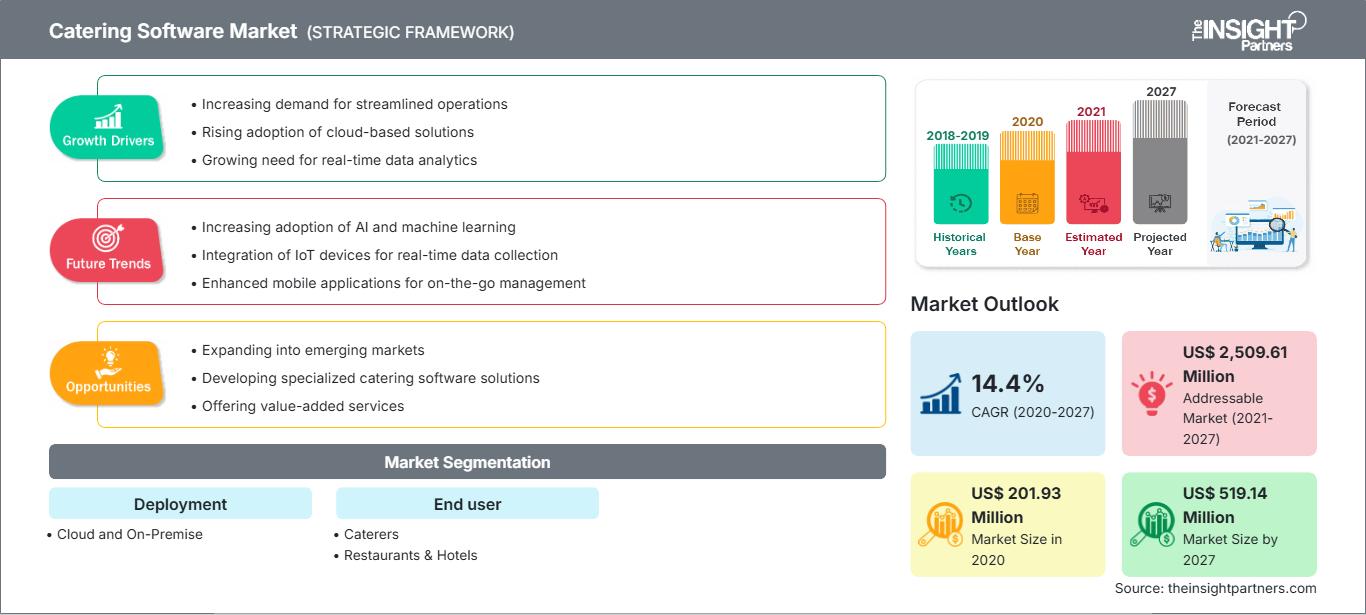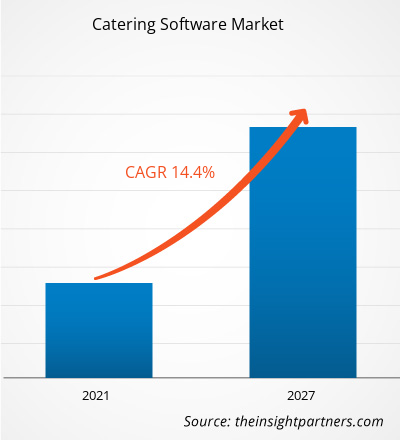Si prevede che il mercato del software per la ristorazione crescerà da 201,93 milioni di dollari nel 2020 a 519,14 milioni di dollari entro il 2027; si stima una crescita a un CAGR del 14,4% dal 2020 al 2027.
La tecnologia di analisi dei Big Data per migliorare le operazioni di ristorazione sta contribuendo alla crescita del mercato. La tecnologia di analisi dei Big Data ha un enorme potenziale per trasformare completamente il settore della ristorazione. L'adozione di soluzioni Big Data contribuisce a migliorare l'efficienza delle reti di distribuzione e produzione nel settore della ristorazione in generale. La tecnologia consente di tracciare l'intero processo di trasporto delle forniture. Grazie a informazioni in tempo reale, i clienti possono monitorare i propri ordini di acquisto sui propri dispositivi e verificare lo stato del servizio di ristorazione. L'integrazione di una dashboard di analisi nel software per la ristorazione aiuta a monitorare e valutare le prestazioni degli operatori del settore. Inoltre, ogni stakeholder del settore della ristorazione deve disporre di dati rilevanti sui propri prodotti, inclusi i dati relativi ad agricoltori, spedizionieri e rivenditori, fino a ristoranti e negozi. Ad esempio, il ristorante KFC utilizza strumenti Big Data per analizzare il feedback dei clienti e le preferenze alimentari, migliorando l'esperienza dei clienti, le vendite e i profitti.
Il settore dell'e-commerce in tutte le regioni ha assistito a numerose trasformazioni negli ultimi anni; la crescita del settore ha spinto gli operatori del mercato dei software per la ristorazione a sfruttare l'analisi dei Big Data per prendere decisioni aziendali più intelligenti. La tecnologia consente ai rivenditori online di valutare le interazioni con i clienti attraverso canali come dispositivi mobili, social media e siti web.
Personalizza questo rapporto in base alle tue esigenze
Potrai personalizzare gratuitamente qualsiasi rapporto, comprese parti di questo rapporto, o analisi a livello di paese, pacchetto dati Excel, oltre a usufruire di grandi offerte e sconti per start-up e università
Mercato del software per la ristorazione: Approfondimenti strategici

- Ottieni le principali tendenze chiave del mercato di questo rapporto.Questo campione GRATUITO includerà l'analisi dei dati, che vanno dalle tendenze di mercato alle stime e alle previsioni.
Impatto della pandemia di COVID-19 sul mercato dei software per la ristorazione
Potrai personalizzare gratuitamente qualsiasi rapporto, comprese parti di questo rapporto, o analisi a livello di paese, pacchetto dati Excel, oltre a usufruire di grandi offerte e sconti per start-up e università
Mercato del software per la ristorazione: Approfondimenti strategici

- Ottieni le principali tendenze chiave del mercato di questo rapporto.Questo campione GRATUITO includerà l'analisi dei dati, che vanno dalle tendenze di mercato alle stime e alle previsioni.
A seguito dello scoppio globale della pandemia di COVID-19, alcune aziende sono state costrette a ridurre le proprie attività a causa delle varie misure di contenimento emanate dai governi di tutto il mondo. La rapida diffusione del virus ha spinto i governi di tutto il mondo a imporre severe restrizioni alla circolazione di persone e veicoli. Le aziende che si basano sull'interazione fisica per generare fatturato sono state gravemente danneggiate dai lockdown. Di conseguenza, alcune aziende si stanno concentrando sull'aumento di conversioni, interazioni e fatturato attraverso i media digitali.
Approfondimenti di mercato: il mercato dei software per la ristorazione: l'apprendimento automatico rivoluzionerà il settore della ristorazione
Nel settore della ristorazione, l'inadeguatezza della mappatura delle aree e lo squilibrio tra domanda e disponibilità di risorse comportano diverse sfide. L'apprendimento automatico e l'intelligenza artificiale (IA) sono le basi delle tecnologie di ristorazione di nuova generazione. Queste tecnologie consentono ai sistemi di apprendere dai dati registrati, che comprendono algoritmi, modelli e informazioni predittive. Diverse aziende di consegna di cibo online stanno adottando la tecnologia di apprendimento automatico per migliorare la propria attività di catering e aumentarne l'efficienza. Ad esempio, Deliveroo, un'azienda di consegna di cibo con sede nel Regno Unito, investe in tecnologie avanzate come l'apprendimento automatico per rimanere competitiva sul mercato offrendo un servizio di consegna di cibo più efficace. Anche Glovo, un'azienda di consegna di cibo con sede in Spagna, utilizza l'apprendimento automatico per prevedere la probabilità di rimanere attivi sull'app. Pertanto, si prevede che l'integrazione dell'apprendimento automatico nelle attività di catering aumenterà la domanda di software per la ristorazione durante il periodo di previsione.
Approfondimenti basati sull'implementazione
In base al tipo di implementazione, il mercato del software per la ristorazione è segmentato in cloud e on-premise. Il segmento cloud ha detenuto la quota di mercato maggiore nel 2019.
Mercato del software per la ristorazione
Le tendenze regionali e i fattori che influenzano il mercato del software per la ristorazione durante il periodo di previsione sono stati ampiamente spiegati dagli analisti di The Insight Partners. Questa sezione illustra anche i segmenti e la geografia del mercato del software per la ristorazione in Nord America, Europa, Asia-Pacifico, Medio Oriente e Africa, America Meridionale e Centrale.
Ambito del rapporto di mercato del software di catering
| Attributo del rapporto | Dettagli |
|---|---|
| Dimensioni del mercato in 2020 | US$ 201.93 Million |
| Dimensioni del mercato per 2027 | US$ 519.14 Million |
| CAGR globale (2020 - 2027) | 14.4% |
| Dati storici | 2018-2019 |
| Periodo di previsione | 2021-2027 |
| Segmenti coperti |
By Distribuzione
|
| Regioni e paesi coperti | Nord America
|
| Leader di mercato e profili aziendali chiave |
|
Densità degli operatori del mercato del software per la ristorazione: comprendere il suo impatto sulle dinamiche aziendali
Il mercato dei software per la ristorazione è in rapida crescita, trainato dalla crescente domanda degli utenti finali, dovuta a fattori quali l'evoluzione delle preferenze dei consumatori, i progressi tecnologici e una maggiore consapevolezza dei vantaggi del prodotto. Con l'aumento della domanda, le aziende stanno ampliando la propria offerta, innovando per soddisfare le esigenze dei consumatori e sfruttando le tendenze emergenti, alimentando ulteriormente la crescita del mercato.

- Ottieni il Mercato del software per la ristorazione Panoramica dei principali attori chiave
Gli operatori che operano nel mercato dei software per la ristorazione si concentrano principalmente sullo sviluppo di prodotti avanzati ed efficienti.
- Nel 2020, CaterZen ha investito ore di programmazione dall'inizio di marzo per confermare che ristoranti e aziende di catering possano continuare le operazioni concentrandosi fortemente sugli ordini online e sulla consegna di cibo.
- Nel 2020, Flex Catering ha introdotto il catering KDS (Kitchen Display System), un tipo di schermo digitale che sostituisce gli ordini con biglietti stampati o scritti a mano nei ristoranti e nelle attività alimentari.
Il mercato dei software per la ristorazione è stato segmentato come segue: Software per la ristorazione globale - Per distribuzione
- Cloud
- On-Premise
Software per la ristorazione globale - Per utente finale
- Aziende di catering
- Ristoranti e Hotel
- Altri
Mercato globale del software per la ristorazione – per area geografica
America settentrionale
- Stati Uniti
- Canada
- Messico
Europa
- Francia
- Germania
- Italia
- Russia
- Regno Unito
- Resto d'Europa
Asia Pacifico (APAC)
- Giappone
- Cina
- Australia
- India
- Corea del Sud
- Resto dell'APAC
Medio Oriente e Africa (MEA)
- Arabia Saudita
- Emirati Arabi Uniti
- Sudafrica
- Resto del MEA
Sudamerica (SAM)
- Brasile
- Argentina
- Resto di SAM
Mercato del software per la ristorazione - Profili aziendali
- Aptus Systems Ltd.
- Better Cater, Inc
- Caterease Software
- CaterTrax, Inc.
- CaterZen di Restaurant & Catering Systems
- Flex Catering
- FoodStorm Catering Software (CaterXpress)
- Planning Pod (My Wedding Workbook, LLC)
- Profit Systems Inc.
- Pxier
- Analisi storica (2 anni), anno base, previsione (7 anni) con CAGR
- Analisi PEST e SWOT
- Valore/volume delle dimensioni del mercato - Globale, Regionale, Nazionale
- Industria e panorama competitivo
- Set di dati Excel
Report recenti
Rapporti correlati
Testimonianze
Motivo dell'acquisto
- Processo decisionale informato
- Comprensione delle dinamiche di mercato
- Analisi competitiva
- Analisi dei clienti
- Previsioni di mercato
- Mitigazione del rischio
- Pianificazione strategica
- Giustificazione degli investimenti
- Identificazione dei mercati emergenti
- Miglioramento delle strategie di marketing
- Aumento dell'efficienza operativa
- Allineamento alle tendenze normative




















 Ottieni un campione gratuito per - Mercato del software per la ristorazione
Ottieni un campione gratuito per - Mercato del software per la ristorazione